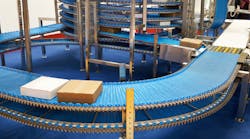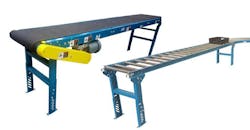How do today’s manufacturers efficiently move bulky materials into, out of, and around their facilities? Engineers at Ultimation Industries, a leader in conveyor technology and automation for nearly 30 years, point to five growing trends in the conveyor industry:
Keep it quiet. The industrial workplace is usually a busy and noisy place, so conveyors shouldn’t add to that. Conveyor manufacturers are increasingly replacing older chain conveyors with automated conveyors. Many use incredibly energy-efficient 24 V dc powered rollers such as Itoh Denki and Interroll motor-driven rollers, which offer quieter operation. These motors are low-voltage with relatively low torque, so they are quiet and smooth enough that people can work in closer proximity to them.
Squeeze it in. Conveyor manufacturers have long sought to put otherwise-wasted factory space to good use. For example, conveyor-design pioneer Jervis B. Webb’s inventions and innovations let companies use the space above the factory for overhead conveyors. But what about spaces elsewhere in the supply chain that don’t get used as productively?
For example, that truck and trailer driving down the highway might be moving automated conveyors on wheels. Our company uses tractor trailers to deliver up to 800 ft of powered roller conveyor to assembly plants. Conveyors also make sure products are loaded and unloaded quickly, continuously remain in the critical production sequence, and always keep the easily-damaged top face of the wheel safe.
Stay small, stay flexible. Highly automated conveyors are great, and Ultimation’s engineers love to design and install them. But sometimes less is more. And while robots are very flexible, the tooling required to hold parts in position for robots is often more expensive than the robot itself. Lots of Ultimation’s customers are looking for conveyor types like simple belt conveyors or roller conveyors to get their productivity efforts moving ahead. Lean production, less walking, less bending—and less capital spending. Many of them ship the same day.
Spread it around. The time spent commissioning large conveyors can be substantial. But that time can be significantly reduced if the conveyor uses distributed, autonomous control. Distributed motor starters, such as Rockwell Allen-Bradley ArmorStart range have been used by conveyor makers for years. 24 V dc powered-roller conveyors connected to the internet (think “Internet of Things”) can reduce the time spent in the field by conveyor makers and their and expensive controls engineers to install and troubleshoot.
For example, at under $200, Interolls’ MultiControl Card controls up to four MDR motors, links to various networks, and provides pre-programmed distributed control routines. In layman’s terms, it controls the buffer and feeding of lines without expensive central processors or lots of engineers.
Throw it out, but keep the frames. The new year is a great time to clean up and to think about new equipment. But before you throw out that old gravity roller conveyor, did you know you can upgrade it into a motorized roller conveyor? Companies like Ultimation have developed retrofit kits to convert existing gravity roller conveyors using either Itoh Denki or Interroll MDR technology.
The kits include everything needed for a conversion, including power supplies, motors, idler gravity rollers, drive belts, cables, and power suppliers. Some of Ultimation’s customers have miles of gravity roller conveyors they will eventually convert to motorized conveyors.
Today’s conveyors offer many innovations that increase material handling efficiency, so it’s worth the time to rethink your current conveyors.
Kali Cresent is a marketing specialist at Ultimation Industries LLC, a company that designs, manufacturers, and installs machinery and equipment, including conveyors., If you have any questions about conveyors, call Ultimation at (586) 771-1881.


